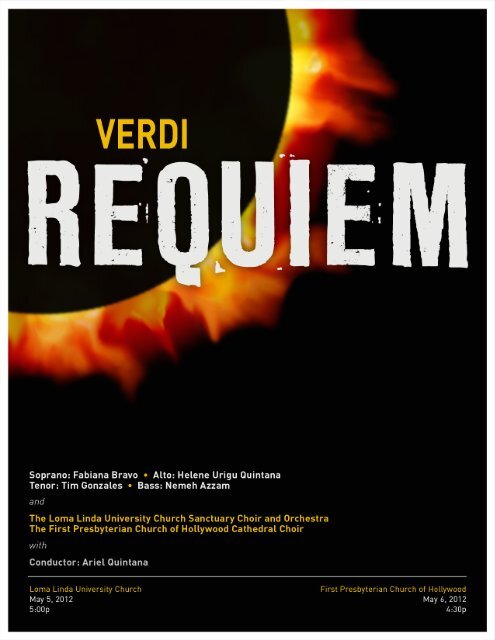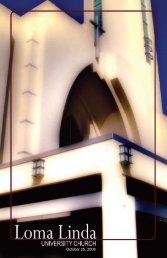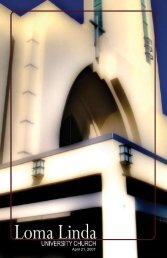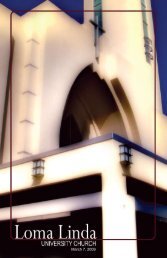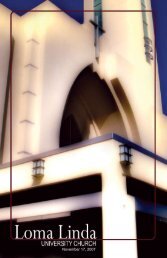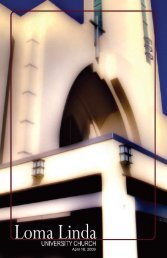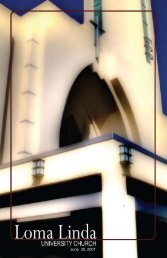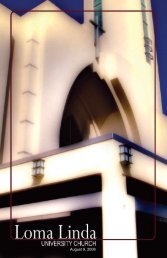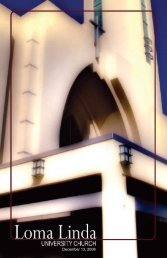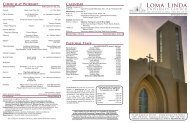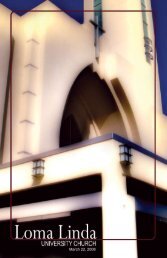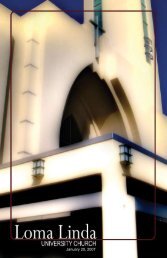LLUC Verdi Requiem Concert Program - Loma Linda University ...
LLUC Verdi Requiem Concert Program - Loma Linda University ...
LLUC Verdi Requiem Concert Program - Loma Linda University ...
- No tags were found...
You also want an ePaper? Increase the reach of your titles
YUMPU automatically turns print PDFs into web optimized ePapers that Google loves.
VERDI<br />
REQUIEM 1
Giuseppe <strong>Verdi</strong><br />
Messa da <strong>Requiem</strong><br />
(“<strong>Requiem</strong>”)<br />
<strong>Requiem</strong><br />
Dies irae<br />
Dies irae<br />
Tuba mirum<br />
Mors stupebit<br />
Liber scriptus<br />
Quid sum miser<br />
Rex tremendae<br />
Recordare<br />
Ingemisco<br />
Confuntatis<br />
Lacrymosa<br />
Offertory<br />
Sanctus<br />
Agnus Dei<br />
Lux aeterna<br />
Libera me<br />
About the Music<br />
Messa da <strong>Requiem</strong><br />
Composed 1873–1874<br />
Orchestration: piccolo, 2 flutes, 2 oboes, 2 clarinets, 4 bassoons, 4 horns,<br />
4 trumpets, 4 off-stage trumpets, 3 trombones, ophicleide*, timpani, bass<br />
drum, strings, chorus, and soloists. (*Obsolete bass instrument replaced by<br />
a tuba.)<br />
In 1873, the year he composed his <strong>Requiem</strong>, Giuseppe <strong>Verdi</strong> had reached<br />
an enviable position among his compatriots. Born in 1813 in humble<br />
circumstances, he had slowly but steadily risen to become the most famous<br />
Italian composer of his time. His operas were the most popular ones in his<br />
home country, his name was familiar in all households, and his melodies<br />
were sung in the streets of every Italian city. His works had triumphed not<br />
only in Italy but had conquered all the capitals of Europe and beyond. They<br />
were performed in all the major theaters from Madrid to St. Petersburg and<br />
from London to Cairo.<br />
When <strong>Verdi</strong> received the news that Alessandro Manzoni, the great man of<br />
Italian letters and respected political figure, had died on 22 May 1873, he<br />
was deeply saddened and he decided to compose a work to pay homage to<br />
a man he venerated as a writer and patriot. For this purpose he turned to a<br />
piece he had composed four years earlier as part of another commemorative<br />
project. This consisted of a <strong>Requiem</strong> mass to which a number of Italian<br />
composers, including <strong>Verdi</strong>, had contributed and that was to be performed<br />
on the anniversary of Gioachino Rossini’s death. The performance of this<br />
work, however, never took place, and <strong>Verdi</strong> set aside the piece he had written.<br />
In 1773, wishing to honor Manzoni on the anniversary of his death, he began the composition of a complete <strong>Requiem</strong> Mass using<br />
his earlier piece, the Libera me, as the starting point. The work received its first performance on 22 May 1874 in the church of San<br />
Marco in Milan under <strong>Verdi</strong>’s conductorship. On 25, 27, and 29 of the same month the work was performed to great acclaim at the<br />
Teatro alla Scala in Milan. And in little more than a year it was performed with great success in Paris, New York, London, and Vienna.<br />
Why did <strong>Verdi</strong> choose the text of the Mass for the Dead for a commemorative work, one may ask. All the evidence indicates that <strong>Verdi</strong><br />
did not intend the work to be a confession of faith but rather a public ceremony of homage. Before <strong>Verdi</strong>, Cherubini and Berlioz had<br />
used the text for musical <strong>Requiem</strong>s designed for political celebrations. The <strong>Requiem</strong> Mass provided a ready-made text that gave <strong>Verdi</strong><br />
ample opportunities to apply his vast experience as a composer of vocal dramatic music.<br />
Throughout the history of <strong>Requiem</strong> Mass settings, composers have shown particular attraction to the text of the Sequence “Dies<br />
irae” because of the possibilities it offers for dramatic musical expression. The “Dies irae” is a long poetic text attributed to Thomas of<br />
Celano (died about 1250). The poem consists of seventeen three-line stanzas, all lines in each stanza rhyming together, and a four-line<br />
stanza at the end (the final two unmetrical lines are later additions). The poem paints in solemn terms the awe-inspiring events of<br />
the Last Judgment, the sound of trumpets, the burning of the earth, and the gathering of humankind before the Judgment Throne. In<br />
contrast to this picture, the text is also a prayer for deliverance from eternal punishment and for admittance to God’s kingdom with<br />
all the redeemed. The student of the Bible will notice the varied imagery drawn from Scripture throughout the poem.<br />
2<br />
VERDI<br />
REQUIEM
REQUIEM<br />
<strong>Requiem</strong> aeternam dona eis, Domine:<br />
et lux perpetua luceat eis.<br />
Te decet hymnus, Deus, in Sion,<br />
et tibi reddetur votum in Jerusalem:<br />
Exaudi orationem meam,<br />
ad te omnis caro veniet.<br />
<strong>Requiem</strong> aeternam dona eis, Domine:<br />
et lux perpetua luceat eis.<br />
Eternal rest grant them, O Lord;<br />
and let perpetual light shine upon them.<br />
A hymn is owed to Thee, O God, in Zion:<br />
and a vow shall be returned to Thee in Jerusalem.<br />
Hear my prayer:<br />
to Thee shall come all flesh.<br />
Eternal rest grant them, O Lord;<br />
and let perpetual light shine upon them.<br />
The movement, marked Andante, opens with a descending melodic idea in the lower strings anticipating the somber mood of the<br />
text. The chorus pronounces, almost like a murmur, the first words “as soft as possible,” according to <strong>Verdi</strong>’s instructions. Then an<br />
unexpected change to the major mode, like a ray of sunshine parting the clouds, underlines the words, “et lux perpetua” (perpetual<br />
light).<br />
The music presents an abrupt dynamic and tonal shift with the entrance of the chorus, unaccompanied, proclaiming the praises of<br />
God: “Te decet hymnus” (A hymn is owed to Thee). This is one example of <strong>Verdi</strong>’s skillful use of sudden loud dynamic changes for<br />
expressive as well as dramatic purposes. For the repeat of the first words, <strong>Verdi</strong> restates the music of the beginning almost intact.<br />
The main change comes at the very end of the section when a rapid crescendo leads without interruption to the “Kyrie eleison.”<br />
Kyrie eleison.<br />
Christe eleison.<br />
Kyrie eleison.<br />
Lord, have mercy.<br />
Christ, have mercy.<br />
Lord, have mercy.<br />
The “Kyrie” marks the entrance of the quartet of soloists. First introduced by the tenor and then repeated by the other solo voices,<br />
a new melodic idea describing a broad, soaring arch gives modern expression to the ancient text. One writer has characterized this<br />
passage as “the most moving passage in all <strong>Verdi</strong>’s works; unquestionably, one of the greater monuments of musical pathos.” The<br />
impression on the listener is unforgettable. <strong>Verdi</strong> entrusted the opening text of the movement to the chorus; now he gives the words<br />
“Kyrie eleison, Christe eleison” (Lord, have mercy; Christ, have mercy) to the solo voices, making them more personal and thus<br />
drawing the individual listener to identify with the soloists’ plea for mercy. In the “Kyrie,” the chorus takes on a supportive role.<br />
DIES IRAE<br />
Dies irae<br />
Dies irae, dies illa,<br />
Solvet saeclum in favilla:<br />
Teste David cum Sibylla.<br />
Quantus tremor est futurus,<br />
Quando judex est venturus,<br />
Cuncta stricte discussurus!<br />
Day of wrath, that day<br />
will dissolve the world into ashes<br />
as David and the Sibyl bear witness.<br />
How great a trembling there shall be<br />
when the judge shall come<br />
to separate everything strictly.<br />
In this movement, appropriately marked Allegro agitato, <strong>Verdi</strong> unleashes all the instrumental, choral, harmonic, rhythmic, and<br />
dynamic resources at his disposal to dramatize the frightfulness of “that day,” the Day of Judgment. Powerful hammering chords,<br />
chromatic lines, rushing scales, calls to attention on the brass instruments, all paint a terrifying picture. Gradually the music<br />
subsides into soft dynamics but without losing its inner energy. This leads to the second stanza (“Quantus tremor”) in which the<br />
chorus utters the words haltingly, in hushed tones, like someone that can hardly speak. (<strong>Verdi</strong> brings back the words and music of<br />
the Dies irae two times in the course of the Sequence as a means to unify the entire movement.)<br />
VERDI<br />
REQUIEM 3
Tuba mirum<br />
Tuba mirum spargens sonum<br />
Per sepulchra regionum,<br />
Coget omnes ante thronum.<br />
A trumpet, spreading its wondrous sound<br />
through the graves of the earth,<br />
will summon all before the throne.<br />
Directly connected with the preceding section, the “Tuba mirum” begins with a series of fanfarelike calls by the brasses. For this <strong>Verdi</strong> requires<br />
four off-stage trumpets that dialogue with the orchestra brasses, first softly but then with growing intensity and increasing rhythmic activity. The<br />
effect of the trumpets summoning the dead to appear before the judgment throne is overwhelming. The listener is forcefully made aware of the<br />
gravity of the moment. With the support of the brasses, fortissimo, the choral basses present the text first and then the sopranos pronounce the<br />
syllables slowly on a long, sustained note as if unable to overcome their astonishment at the scene. The section ends abruptly with a loud chord.<br />
Mors stupebit<br />
Mors stupebit et natura,<br />
Cum resurget creatura,<br />
Judicanti responsura.<br />
Death and nature will stand stupefied<br />
when the dead arise<br />
to answer Him who judges.<br />
The “Mors stupebit,” allotted to the bass soloist, is a short section characterized by a short, insistent motive whose notes are broken by rests and<br />
long pauses. This melodic idea in the orchestra vividly portrays Death’s amazement before the judgment throne. The soloists intones the words<br />
with a dotted-note rhythm, ascending by steps with ever growing urgency only to sink down into almost complete speechlessness and silence at<br />
the end.<br />
Liber scriptus<br />
Liber scriptus proferetur,<br />
In quo totum continetur,<br />
Unde mundus judicetur.<br />
Judex ergo cum sedebit<br />
Quidquid latet, apparebit:<br />
Nil inultum remanebit.<br />
[Dies irae, dies illa,<br />
Solvet saeclum in favilla:<br />
Teste David cum Sibylla.]<br />
The written book shall be brought forth<br />
in which all is contained<br />
whereby the world is judged.<br />
When the judge, therefore, takes his seat,<br />
all that is hidden shall appear;<br />
nothing shall remain unpunished.<br />
[Day of wrath, that day<br />
will dissolve the world into ashes<br />
as David and the Sibyl bear witness.]<br />
The mezzo-soprano soloist brings to mind Daniel’s vision of the Judge, who will open the books to judge the world according to the deeds<br />
recorded in them. At the beginning the accompaniment, punctuated by soft timpani rolls, is ominous, but then becomes agitated with a fast<br />
rumbling bass. The orchestra brasses come again into prominence to announce the presence of the Judge (“Judex ergo”). The section ends<br />
with another passage broken up by rests in which the spectator falters under the weight of the scene. Throughout the section the choir recalls<br />
the “dies irae” motive in dark, subdued tones. After the soloist’s final outcry, the orchestra grows in intensity and agitation, leading to the first,<br />
abbreviated, return of the “dies irae” music.<br />
Quid sum miser<br />
Quid sum miser tunc dicturus,<br />
Quem patronum rogaturus,<br />
Cum vix justus sit securus<br />
What am I to say then, wretch that I am<br />
Whom shall I call as patron<br />
when scarcely the just may be secure<br />
With this section, the poem turns to the first person. The individual is no longer a spectator narrating the scene unfolding before his eyes but a<br />
participant in the events of the drama. The music introduces a characteristic ascending figure in the solo bassoon that dominates much of the<br />
section. The tempo is Adagio and thus it introduces a moment of respite in the intensely unsettling music of the preceding sections. The three<br />
soloists—mezzo-soprano, tenor, and bass—state the text four times, the first three times ending with a beautiful cadential gesture that fails,<br />
however, to come to a complete closure. At the conclusion of the section, the soloists, unaccompanied, repeat the words, one line at a time. The<br />
music, ending with no resolution, thus graphically portrays the desolation of the penitent standing alone without apparent protection. From a<br />
musical point of view, the stark nakedness of this conclusion sets in high relief the vision of the “King of great majesty” in the ensuing section.<br />
4<br />
VERDI<br />
REQUIEM
Rex tremendae<br />
Rex tremendae majestatis,<br />
Qui salvandos salvas gratis,<br />
Salva me, fons pietatis.<br />
King of great majesty,<br />
who freely save those worthy of salvation,<br />
save me, fount of mercy.<br />
The penitent, having found no succor elsewhere, turns to God to ask for salvation. Like the Kyrie in the first movement, the four soloists and the<br />
chorus join forces once again to present their pleas to God. Here <strong>Verdi</strong> uses two contrasting melodic ideas. The first is a marchlike descending<br />
line announced by the choral basses. In its rapid descent and decrescendo dynamics, this idea seems to represent the repentant sinner who<br />
falls prostrate before the “King of terrible majesty.” The second idea, first introduced by the bass soloist, is a short, lyrical melody expressing the<br />
soul’s cry for deliverance: “Salva me, fons pietatis” (Save me, fount of mercy). The two ideas are initially presented in succession but are soon<br />
superimposed, the entire musical structure leading to expansive climaxes as if bringing the whole of humankind together in a fervent prayer for<br />
salvation. The section, which exhibits a rich harmonic palette, comes to an end with a final, hymnlike restatement of the “salva me” motive that,<br />
in its simplicity, seems to summarize humanity’s longing for deliverance. The section proceeds to the next one through a transitional passage that<br />
anticipates the accompaniment in the music to follow.<br />
Recordare<br />
Recordare, Jesu pie,<br />
Quod sum causa tuae viae:<br />
Ne me perdas illa die.<br />
Quearens me sedisti lassus:<br />
Redemisti crucem passus:<br />
Tantus labor non sit cassus.<br />
Juste judex ultionis,<br />
Donum fac remissionis<br />
Ante diem rationis.<br />
Remember, merciful Jesus,<br />
that I am the cause of Thy journey;<br />
do not destroy me on that day.<br />
Seeking me, Thou didst sit weary;<br />
Thou didst redeem me, having suffered the cross.<br />
May such suffering not be in vain.<br />
As the just Judge of vengeance,<br />
grant the gift of remission<br />
before the day of reckoning.<br />
While the minor mode has dominated the music of the movement up to this point, the “Recordare” is anchored in the major mode. The poem<br />
leaves behind the imagery of the dread-filling judgment and awe-inspiring King and turns to the “merciful Jesus.” The words are set to a serene<br />
melody first introduced by the mezzo-soprano soloist and then repeated by the soprano. The second stanza, with its allusion to Jesus’ suffering,<br />
temporarily reintroduces the minor mode but ends in the major. The last stanza, although recalling the vision of the avenging Judge (“Juste<br />
judex”), is set to the opening music. Towards the end the voices break out in an expressive cadenza and continue with increasing urgency to a<br />
final climax. The music ends quietly.<br />
Ingemisco<br />
Ingemisco tamquam reus:<br />
Culpa rubet vultus meus;<br />
Supplicanti parce, Deus.<br />
Qui Mariam absolvisti<br />
Et latronem exaudisti,<br />
Mihi quoque spem dedisti.<br />
Preces meae non sunt dignae:<br />
Sed tu bonus fac benigne,<br />
Ne perenni cremer igne.<br />
Inter oves locum praesta,<br />
Et ab haedis me sequestra,<br />
Statuens in parte dextra.<br />
I groan like a criminal;<br />
blame reddens my face.<br />
Spare a supplicant, O God.<br />
Thou who didst absolve Mary [Magdalene]<br />
and didst harken to the thief,<br />
to me also Thou gavest hope.<br />
My prayers are not worthy,<br />
but, Kind One, grant<br />
that I may not burn in everlasting fire.<br />
Give me place among the sheep<br />
and separate me from the goats,<br />
placing me by Thy right hand.<br />
This section, for the tenor soloist, comprises four stanzas, each receiving its own musical treatment. The first is set in a declamatory style, only<br />
the word “supplicant” receiving special emphasis by being stated twice and sung to the highest note of the passage. The music thus puts the<br />
focus on the individual bowing before God. The next stanza, which claims God’s mercy as He had been merciful to Mary and the thief on the<br />
cross, presents a more confident melody supported by an assertive orchestral accompaniment. The third stanza, bringing an acknowledgment<br />
of the speaker’s own unworthiness and recalling the specter of eternal perdition, reverts again to a more anxious, halting utterance of the<br />
words. And finally, the fourth stanza, reflecting a more positive picture, is set to a lyrical melody that recalls that of the second stanza. The soft<br />
accompaniment with high strings seems to anticipate the heavenly bliss promised to those placed with the sheep. At the end the singer’s assured,<br />
decisive ascent towards the concluding cadence, becomes an affirmation of trust in God’s right hand.<br />
VERDI<br />
REQUIEM 5
Confutatis<br />
Confutatis maledictis,<br />
Flammis acribus addictis,<br />
Voca me cum benedictis.<br />
Oro supplex et acclinis,<br />
Cor contritum quasi cinis:<br />
Gere curam mei finis.<br />
[Dies irae, dies illa,<br />
Solvet saeclum in favilla:<br />
Teste David cum Sibylla.]<br />
When the damned are confounded<br />
and given over to bitter flames,<br />
call me with the blessed.<br />
I pray, supplicant and prostrate,<br />
heart contrite as if in ashes,<br />
safeguard my end.<br />
[Day of wrath, that day<br />
will dissolve the world into ashes<br />
as David and the Sibyl bear witness.]<br />
As soon as the tenor soloist reaches its final note in the preceding section, the orchestra introduces an ominous chord followed by a threatening<br />
ascending chromatic line that leads directly to the entrance of the bass soloist. The text of this section paints two opposing views. The initial<br />
two lines bring to mind once again the terrible fate of the damned while the last four lines renew the contrite penitent’s pleading with God<br />
for salvation. <strong>Verdi</strong> represents the contrast with correspondingly contrasting music. He expresses the imagery of the condemned through a<br />
note repeated with an insistent rhythm and underlined by menacing loud chords or rushing scales. And he conveys the words of the penitent<br />
kneeling before God through a smooth, lyrical melodic line, supported by an accompaniment of softly repeated chords. The last note of the<br />
soloist is savagely interrupted by an abrupt shift of key and the return of the pounding chords of the “dies irae” music. This is the third and last<br />
appearance of this music in the movement. (The final recurrence occurs in the closing movement of the work.) It is clear that <strong>Verdi</strong> reintroduced<br />
the text and music of the beginning here to present a dramatic interruption that effectively endows the following, concluding prayer for salvation<br />
with a deeper meaning.<br />
Lacrymosa<br />
Lacrymosa dies illa,<br />
Qua resurget ex favilla<br />
Judicandus homo reus:<br />
Huic ergo parce, Deus.<br />
Pie Jesu Domine,<br />
Dona eis requiem. Amen.<br />
Mournful shall be that day<br />
when arises from the ashes<br />
guilty man to be judged;<br />
therefore spare him, O God.<br />
Merciful Lord Jesus,<br />
grant them rest. Amen.<br />
While the “dies irae” music immediately preceding vividly depicts the “day of wrath,” this concluding section reflects the sentiments of<br />
that “mournful day.” Here <strong>Verdi</strong> once again brings the quartet of soloists, chorus, and orchestra together to round off the movement. The<br />
“Lacrymosa,” marked Largo, is appropriately cast in the minor mode; it opens with the mezzo-soprano soloist singing the first four lines of<br />
the text with a melody that reappears complete or in fragments throughout the section. When the bass soloist repeats the melody, the mezzosoprano<br />
superimposes a slowly ascending line that breaks off each syllable as if sobbing. A similar treatment is given to the words a few measures<br />
later when the soprano sings a countermelody, marked “lamenting,” above the main theme carried by the choral tenors and basses. Throughout<br />
the first part of this section <strong>Verdi</strong> gives the soprano soloist extended melodies that soar high above the rest of the ensemble. At the entrance of<br />
the “Pie Jesu Domine,” sung by the quartet of soloists without accompaniment, the music shifts to the major mode to convey a sense of trust in<br />
Jesus’ mercy. This music is most expressive and harmonically rich involving an unexpected tonal detour. In the concluding measures the soloists<br />
and chorus sing in subdued, low tones while the orchestra shifts from the minor to the major mode. This modal change confers the music a<br />
peaceful mood that is in utter contrast to the tumultuous, angry music at the beginning of the movement. The final “amen” is sung to a chord<br />
quite unrelated to the surrounding harmony; it is as if a beam of light, like a blessing, descended upon the praying assembly.<br />
6<br />
VERDI<br />
REQUIEM
OFFERTORY<br />
Domine Jesu Christe, Rex gloriae<br />
libera animas omnium fidelium defunctorum<br />
de poenis inferni et de profundo lacu:<br />
libera eas de ore leonis,<br />
ne absorbeat eas tartarus, ne cadant in obscurum:<br />
sed signifer sanctus Michael<br />
repraesentet eas in lucem sanctam:<br />
Quam olim Abrahae promisisti<br />
et semini ejus.<br />
Lord Jesus Christ, King of glory,<br />
deliver the souls of all the faithful departed<br />
from the torments of hell, and from the bottomless pit;<br />
deliver them from the lion’s mouth,<br />
lest hell swallow them, lest they fall into the darkness:<br />
But let Saint Michael, the standard-bearer,<br />
bring them forth into the holy light.<br />
Which Thou didst once promise unto Abraham<br />
and unto his seed.<br />
After the turmoil that dominated large parts of the Dies irae the Offertory is characterized by a mostly quiet, contemplative mood. The<br />
movement, assigned to the quartet of soloists, is divided into four main sections and a coda.<br />
The short orchestral introduction—consisting of slowly ascending and descending arpeggios in the violoncellos punctuated by woodwind<br />
chords—introduces the main melodic theme of the movement. The voices, a duet for mezzo-soprano and tenor, present short phrases<br />
alternating with the theme played without accompaniment. The entrance of the bass places the theme in the voices for the first time; this<br />
entrance opens a passage during which the voices interplay through dialogue and imitation. Then the soprano, in one of the greatest moments<br />
in the work, enters with a long held note supported by an ethereal accompaniment high in the string register. <strong>Verdi</strong> could not have created a<br />
better effect to express the shift from darkness to light in the text. At the end of the section all four soloists unite in singing the words “in lucem<br />
sanctam” (into the holy light) to a most effective, luminous cadence.<br />
In the brief second section, “Quam olim Abrahae,” the text is set to music in a faster tempo and extremely varied harmonization. The voices<br />
build up the dynamic level to a fortissimo and rapidly dissolve into a pianissimo through a surprising modulation in preparation for the<br />
“Hostias.”<br />
Hostias et preces tibi, Domine, laudis offerimus:<br />
tu suscipe pro animabus illis,<br />
quarum hodie memoriam facimus:<br />
fac eas, Domine, de morte transire ad vitam.<br />
Quam olim Abrahae promisisti<br />
et semini ejus.<br />
To Thee, O Lord, we render our offerings and prayers with praise:<br />
accept them on behalf of the souls<br />
we commemorate this day;<br />
make them, O Lord, pass from death unto life.<br />
Which Thou didst once promise unto Abraham<br />
and unto his seed.<br />
The “Hostias” is based on a serene melodic idea—first given to the tenor voice—that more than any other melody in the entire work seems to<br />
convey a religious sentiment. Short episodes in minor mode, reflecting the allusion to death, darken the tone of the music, but in the end the<br />
major mode triumphs in a delicate passage for a high flute and pianissimo tremolo strings while the voices enunciate the words in muted tones<br />
as if speaking. “Quam olim Abrahae” is restated to the original music.<br />
Libera animas omnium fidelium defunctorum<br />
de poenis inferni:<br />
fac eas, Domine, de morte transire ad vitam.<br />
Deliver the souls of all the faithful departed<br />
from the torments of hell;<br />
make them, O Lord, pass from death unto life.<br />
The coda brings back the melodic theme of the opening section sung pianissimo by the four solo voices in unison. At the end the soprano rises<br />
to a high sustained note signifying the transition from death to life, and the orchestra closes with the shimmering sound of the high strings.<br />
VERDI<br />
REQUIEM 7
SANCTUS<br />
Sanctus, sanctus, sanctus, Dominus Deus Sabaoth!<br />
Pleni sunt coeli et terra gloria tua.<br />
Hosanna in excelsis.<br />
Benedictus qui venit in nomine Domini.<br />
Hosanna in excelsis.<br />
Holy, Holy, Holy, Lord God of Hosts!<br />
Heaven and earth are full of Thy glory.<br />
Hosanna in the highest.<br />
Blessed is he that cometh in the name of the Lord.<br />
Hosanna in the highest.<br />
Unlike many other composers, who in their settings of this text strive to convey a solemn mood, <strong>Verdi</strong> creates here exhuberant, joyous music<br />
that dwells not on a sentiment of awe but rather on the idea that “heaven and earth are full of Thy glory.” The movement opens with a short<br />
introduction in which trumpet fanfares announce the initial threefold acclamation “Sanctus, sanctus, sanctus.” The music then embarks on<br />
a fugue for double chorus permeated by a thematic idea first sung by the sopranos. The head of this subject—five ascending notes outlining<br />
the tonic chord—recurs persistently endowing the music with great vitality and forward drive. The continuous entrances of this motive, being<br />
tossed from voice to voice, seem to portray a great multitude of angels in heaven who vie with each other as they render their praises to God.<br />
The dialoguing voices eventually come together and sing in more sustained notes, the two choruses alternating and responding to each other in<br />
hymnlike fashion. Meanwhile the orchestra fills the background with lively figuration to maintain the momentum of the music. At the end all<br />
voices and orchestra join together, fortissimo, in a final “Hosanna in the highest.”<br />
AGNUS DEI<br />
Agnus Dei, qui tollis peccata mundi:<br />
dona eis requiem.<br />
Agnus Dei, qui tollis peccata mundi:<br />
dona eis requiem.<br />
Agnus Dei, qui tollis peccata mundi:<br />
dona eis requiem sempiternam.<br />
Lamb of God, that takest away the sins of the world,<br />
grant them rest.<br />
Lamb of God, that takest away the sins of the world,<br />
grant them rest.<br />
Lamb of God, that takest away the sins of the world,<br />
grant them eternal rest.<br />
In this movement, marked Andante, <strong>Verdi</strong> maintained a uniform expression by using a single melodic period that is repeated with varying<br />
harmonies and instrumental accompaniments. The soprano and mezzo-soprano soloists sing the simple, expressive melody in octaves conveying<br />
a deep sense of serenity and confidence. There are no outbursts of despair or expressions of doubt, only a quiet confidence in that the Lamb of<br />
God is already disposed to granting the petitioner’s prayers. Following each of the soloists’ three entries, the chorus responds with a restatement<br />
of the melody. The dynamic level throughout the movement is subdued hardly rising above piano.<br />
LUX AETERNA<br />
Lux aeterna luceat eis, Domine:<br />
Cum sanctis tuis in aeternum,<br />
quia pius es.<br />
<strong>Requiem</strong> aeternam dona eis, Domine:<br />
et lux perpetua luceat eis.<br />
Cum sanctis tuis in aeternum,<br />
quia pius es.<br />
Lux perpetua luceat eis, Domine:<br />
Let eternal light shine upon them, O Lord.<br />
With Thy saints in eternity,<br />
for Thou art merciful.<br />
Eternal rest grant them, O Lord,<br />
and let perpetual light shine upon them.<br />
With Thy saints in eternity,<br />
for Thou art merciful.<br />
Let perpetual light shine upon them, O Lord.<br />
The words of the Lux aeterna partially restate the text of the opening movement. <strong>Verdi</strong>, nevertheless, did not repeat the same music, preferring<br />
instead to reserve the original musical setting for the reprise of the text in the final movement of the work. Written as a trio for the mezzosoprano,<br />
tenor, and bass soloists, the music progresses mostly through episodes of dialogue among the voices. There are two passages in which<br />
<strong>Verdi</strong> presents the voices without accompaniment. As in previous movements, <strong>Verdi</strong> introduces marked contrast between the ideas of light and<br />
death. At the beginning the mezzo-soprano intones “Lux aeterna luceat eis” (Let eternal light shine upon them) to the sound of high pianissimo<br />
tremolos in the strings. Then the bass sings, in the minor mode, the words “<strong>Requiem</strong> aeternam dona eis” (Eternal rest grant them) to the dark<br />
sound of the bassoons, trombones, and timpani rolls.<br />
8<br />
VERDI<br />
REQUIEM
LIBERA ME<br />
Libera me, Domine, de morte eterna,<br />
in die illa tremenda:<br />
quando coeli movendi sunt et terra.<br />
Dum veneris judicare saeculum per ignem.<br />
Tremens factus sum ego et timeo,<br />
dum discussio venerit atque ventura ira,<br />
quando coeli movendi sunt et terra.<br />
Deliver me, Lord, from eternal death<br />
on that terrible day<br />
when heaven and earth are moved,<br />
when Thou shalt come to judge the world through fire.<br />
I am made to tremble and I fear<br />
when the separation and the anger shall come,<br />
when heaven and earth are moved.<br />
The Libera me is an extended movement for soprano soloist and chorus. It is divided into four distinct sections. The opening section is a<br />
declamatory solo for the soloist (the chorus echoes the speechlike entrance of the soprano only in four bars sung pianissimo). The mood is one<br />
of agitation created both by the melody being broken off by frequent rests and by an unsettled orchestral accompaniment. Despite the last words<br />
“tremens factus, sum ego et timeo” (I am made to tremble and I fear) that the soloist sings to close the section, <strong>Verdi</strong> writes a soft, quiet ending<br />
evidently to enhance the dramatic effect of the music that he is about to unleash.<br />
Dies irae, dies illa, calamitatis et miseriae<br />
dies magna et amara valde.<br />
Dum veneris judicare saeculum per ignem.<br />
Day of wrath, that day of calamity and wretchedness,<br />
great and bitter day,<br />
when Thou shalt come to judge the world through fire.<br />
The second section, written for the chorus, bursts out with great power as earlier in the work. This section is an almost exact reprise of the “dies<br />
irae” music, but not all the same words, from the second movement. As the music subsides towards the end, the soprano enters in an agitated<br />
state to bring to the fore the words “Dum veneris judicare saeculum per ignem” (when Thou shalt come to judge the world through fire) while<br />
the chorus softly repeats “dies irae, dies illa” (day of wrath, that day) like a refrain. Following the last words of the chorus, the orchestra prolongs,<br />
pianissimo, the final harmony in preparation for the next section.<br />
<strong>Requiem</strong> aeternam dona eis, Domine:<br />
et lux perpetua luceat eis.<br />
Eternal rest grant them, O Lord;<br />
and let perpetual light shine upon them.<br />
The third section is a reprise of the “requiem aeternam” music from the opening movement of the work but now rescored as a solo for the<br />
soprano with choral support only. The orchestra is silent. Here <strong>Verdi</strong>’s music is one of the loveliest moments in the entire <strong>Requiem</strong>. Like the<br />
first appearance of this music, the dynamic level fluctuates between pianissimo and piano, only once surging to a forte. Beginning in the minor<br />
mode, the section soon turns to the major mode but always infused by minor-mode inflections that confer on the music an aura of nostalgia and<br />
melancholy. The music ends softly, the soprano singing ethereally a high note.<br />
Libera me, Domine, de morte eterna,<br />
in die illa tremenda:<br />
quando coeli movendi sunt et terra.<br />
Dum veneris judicare saeculum per ignem.<br />
Deliver me, Lord, from eternal death<br />
on that terrible day<br />
when heaven and earth are moved,<br />
when Thou shalt come to judge the world through fire.<br />
The final section brings back part of the text from the first, but the music is new. Written for the chorus, with important solo passages for<br />
the soprano soloist, the section is an energetic fugue based on a melodic subject that recalls the subject of the Sanctus fugue in an upsidedown<br />
form. As it approaches the end, the chorus builds to a climax in which the rhythmic drive of the music seems to acquire a life of its<br />
own independently of the text as it distorts the natural accents of the words. Concerning this fugue, a commentator wrote that the piece is “so<br />
dynamic and insistent that one seems to sense the clamour of a multitude intent on achieving salvation by violence;” such is the force of this<br />
music. In its final bars, the music grows in intensity to the last climax as the soloist ascends to a high note with the support of the entire chorus<br />
and orchestra: “Libera me de morte eterna” (Deliver me from eternal death) is the fervent prayer. But the music does not end loud; almost all of<br />
a sudden it becomes subdued, decreasing to a pianissimo, all the voices in unison repeating the final plea: “Deliver me.” In the end it is not the<br />
commotion of loud cries but the “still small voice” that reaches God’s ear.<br />
René M. Ramos<br />
<strong>Loma</strong> <strong>Linda</strong>, 2012<br />
For much of the material in the notes, I am indebted to David Rosen, <strong>Verdi</strong>: <strong>Requiem</strong>, Cambridge Music Handbooks (Cambridge<br />
<strong>University</strong> Press, 1995).<br />
VERDI<br />
REQUIEM 9
About the Artists<br />
Conductor, pianist, and composer Ariel Quintana, was born in Libertador San Martin, Entre Rios, Argentina.<br />
He began his piano studies at the age of three. He earned a Master degree in music in piano performance from<br />
the National Conservatory of Music in Buenos Aires, Argentina, and a doctorate in choral conducting from the<br />
<strong>University</strong> of Southern California. The list of his teachers and mentors includes Estrella Steger, Perla Brugola,<br />
Julio Fainguersh, Valdo Sciammarella, Waldemar Wensell, Paul Salamunovich, Morten Lauridsen, and William<br />
Dehning. The Los Angeles Master Chorale under maestros Paul Salamunovich and Grant Gershon have sung<br />
some of his arrangements and premiered his Hodie Christus natus est in December 2000. This piece was also<br />
performed at the National Convention of the ACDA in New York in February of 2003. The list of his compositions<br />
and arrangements includes Ave verum corpus, Mass from Two Worlds, Here I Am, La farolera tropezó, All<br />
Creatures of our God and King, and soon to be published Ave maris stella. Dr. Quintana has appeared as a<br />
conductor at the Hollywood Bowl, Dorothy Chandler Pavilion, Ebel Theatre, and Walt Disney <strong>Concert</strong> Hall. In<br />
2006 he was appointed assistant conductor of the Los Angeles Master Chorale, a position that he kept for four<br />
years. Currently he is minister of music at <strong>Loma</strong> <strong>Linda</strong> <strong>University</strong> Church and associate minister of music at<br />
First Presbyterian Church of Hollywood. Besides his activities as a conductor and composer, he maintains an active schedule as a clinician and<br />
adjudicator. A catalog of Ariel’s choral works can be found at www.arielquintana.com.<br />
Kimo Smith, organist and collaborative pianist, began music studies in his home state of Hawaii at age four.<br />
Following his graduation from Hawaiian Mission Academy, he attended the <strong>University</strong> of Hawaii, La Sierra<br />
<strong>University</strong>, the <strong>University</strong> of Southern California, and the <strong>University</strong> of California, Los Angeles. A student of Ladd<br />
Thomas at USC, he completed his Bachelor and Master degrees, magna cum laude, in organ performance. He was<br />
selected to receive the Organ Department Outstanding Achievement Award on both occasions. He completed his<br />
doctoral studies at UCLA in organ performance as a student of Thomas Harmon. Dr. Smith is a past winner of<br />
several competitions sponsored by the American Guild of Organists and Music Teachers National Association.<br />
Dr. Smith is currently associate professor of music at La Sierra <strong>University</strong> and past chair of the Department of<br />
Music. He is an active recitalist, performing locally, nationally, and abroad. As organist, he has appeared as a<br />
guest artist with several Southern California orchestras and choral ensembles, including the Glendale Symphony,<br />
Riverside County Philharmonic Orchestra, Redlands Symphony Orchestra, William Hall Chorale, Los Robles<br />
Master Chorale, Angeles Chorale, and Los Angeles Master Chorale. He is featured organist on a 2010 recording<br />
of the L.A. Master Chorale performing the choral works of emerging young composer Nico Muhly. This was the<br />
first recording of the Master Chorale in Walt Disney <strong>Concert</strong> Hall, and their first for the world-renowned Decca label. He will appear once again<br />
with the LAMC in the opening concert of their 2012–2013 season. Dr. Smith has also been consistently involved in church music since he was<br />
twelve, and is the organist at the First Presbyterian Church of Hollywood and the <strong>University</strong> Church of Seventh-day Adventists in <strong>Loma</strong> <strong>Linda</strong>.<br />
His professional music activities also include a great deal of collaborative performing which has taken him throughout the United States, Europe,<br />
South America, and Asia with touring groups and solo artists. Dr. Smith and his wife, Cheryl, also a professional musician, reside in <strong>Loma</strong><br />
<strong>Linda</strong>, California. They have three children, two grandsons, and a granddaughter.<br />
Soprano Fabiana Bravo made her professional debut in 1996 as Lucia in Lucia di Lammermoor with Luciano<br />
Pavarotti at the Academy of Music in Philadelphia after winning the fifth Luciano Pavarotti International Voice<br />
Competition. Since then she has achieved recognition throughout the United States, Canada, Europe, and Asia for<br />
her operatic and oratorio performances. Highlights of her stellar operatic career include Mimi in La Bohème with<br />
the New York Metropolitan Opera, Madame Butterfly with the San Francisco, Dallas, and Los Angeles Operas,<br />
and the title role in Tosca with the Shanghai Opera in the first ever performance of that opera in China. Her<br />
versatility has garnered her work with various opera companies performing such leading roles as Donna Anna in<br />
Don Giovanni, Leonora in Il Trovatore and Oberto, and the title role in Norma. She made her Carnegie Hall debut<br />
as Fiora in L’amore dei tre re by Montemezzi with the Opera Orchestra of New York. Ms. Bravo toured as soprano<br />
soloist with L’Orchestre Métropolitain of Montreal in performances of <strong>Verdi</strong>’s <strong>Requiem</strong>. She presented a recital<br />
at Castle Gandolfo, Italy, for Pope John Paul II, and also appeared in <strong>Verdi</strong> galas in Prague, and Oviedo, Spain,<br />
as well as in Germany for Operalia with Placido Domingo. In 1999, the Congress of Argentina honored Fabiana<br />
Bravo by declaring her Argentine Woman of the Year for her outstanding contribution to the arts as a young<br />
artist. Ms. Bravo’s future engagements include Oh My Son by Marcos Galvany to be performed at the Vatican for Easter 2013 and appearances as<br />
Santuzza in Cavalleria Rusticana as part of the Metropolitan Opera season 2013–14. She is currently a Professor of Voice at Catholic <strong>University</strong><br />
of America in Washington, D.C. Her recently released album CD <strong>Verdi</strong> and Verismo for Helicon Records has received high critical acclaim.<br />
10<br />
VERDI<br />
REQUIEM
Growing up in Patagonia, Argentina, mezzo-soprano Helene Urigu Quintana began her musical studies at a<br />
very early age. She is a graduate of the National Conservatory of Music of Buenos Aires with a Master of Arts in<br />
piano performance and a Master of Arts with honors in harpsichord performance. She has dedicated over thirty<br />
years to studying the art of classical singing. Ms. Urigu Quintana has appeared as soloist on several occasions<br />
with the Los Angeles Master Chorale under the baton of maestros Paul Salamunovich and Grant Gershon, most<br />
recently in Handel’s Messiah, Whitacre’s Cloudburst, and in both the Christmas Oratorio and the Magnificat by J.<br />
S. Bach. As an operatic singer, she sang the role of Ines in Il Trovatore at the National Opera Theatre in Georgia,<br />
and has sung several roles with the Los Angeles Opera including: The Bridesmaid in Le Nozze di Figaro, Second<br />
Taube in Die Vogel, a Lady in Nicholas and Alexandra, and cover roles for Rosita and Mariana in the zarzuela<br />
Luisa Fernanda. She has been recognized for “…a winning performance…” by the Los Angeles Times, “…strong,<br />
ardent musicality…” by the Beverly Hills Outlook, and “…admirable clarity and power…” by the Monterey Herald.<br />
In June of this year Ms. Urigu Quintana will perform as soloist with the Angeles Chorale in the West Coast<br />
premiere of Robert Cohen’s Alzheimer’s Stories. She maintains an active voice studio in Glendale, California,<br />
where she resides with her husband and sixteen–year old daughter.<br />
Born and trained in Southern California, tenor Tim Gonzales performs opera and oratorio on the national and<br />
international stage. Mr. Gonzales has performed a variety of roles in opera, the most notable being Peter Doyle in<br />
the West Coast premiere of Lowell Lieberman’s Miss Lonelyhearts with the USC Opera. Mr. Gonzales has sung the<br />
roles of Le Doyen in Cendrillon, Arbace in Idomeneo, Tebaldo in Bellini’s I Capuleti e i Montecchi and Albert in<br />
Albert Herring with USC Opera. He has also created the role of Harry Truman in Liliana Primani’s The Truman<br />
Affair, presented at the 2006 Opera America convention in Seattle, Washington. Other performances include<br />
Bach’s Passions and Mass in B Minor, Beethoven’s Ninth Symphony, and Mozart’s C Minor Mass and <strong>Requiem</strong> to<br />
name a few. Mr. Gonzales performed as tenor soloist in the 2005 KMZT broadcast of a performance of Handel’s<br />
Messiah by the Angeles Chorale and recorded Strimple’s Nativities with the London Symphony in September 2008<br />
due out soon on the Naxos label. Mr. Gonzales is currently a member of the Los Angeles Master Chorale and the<br />
Los Angeles Opera Chorus. He holds a BA in music from La Sierra <strong>University</strong> and currently studies voice as a<br />
graduate student at the <strong>University</strong> of Southern California’s Thornton School of Music with noted mezzo-soprano<br />
Cynthia Munzer.<br />
Baritone Nemeh Azzam is a native of Lebanon. He earned his Bachelor of Music and Master of Music<br />
degrees at the Catholic <strong>University</strong> of America in Washington, D.C. Mr. Azzam has performed many<br />
recitals and concerts throughout the United States, Europe, Central and South America, and the Middle<br />
East. Mr. Azzam appeared as soloist in the Fauré and Duruflé <strong>Requiem</strong>s and also sang in televised<br />
performances of Handel’s Messiah and Orff ’s Carmina Burana with the Georgetown Symphony<br />
Orchestra. Mr. Azzam’s recently sung the role of Sharpless in Puccini’s Madama Butterfly in Macedonia,<br />
and the title role in <strong>Verdi</strong>’s Rigoletto with the Bel Cantanti Opera Company in Washington, D.C. The<br />
Washington Post heralded his performance stating: “…a challenging role, musically, theatrically and<br />
psychologically, but Azzam had it completely mastered…” Mr. Azzam has numerous other operatic<br />
credits, including the roles of Amonasro in <strong>Verdi</strong>’s Aida, Germont in <strong>Verdi</strong>’s La traviata, Figaro in<br />
Rossini’s The Barber of Seville, Enrico in Donizetti’s Lucia di Lamermoor, and Sarastro in Mozart’s<br />
The Magic Flute. He has been the winner of numerous competitions, and recipient of many awards<br />
including the Young Singer’s Foundation Award, The Presser Foundation Award, the Metropolitan Opera Regional Award, and<br />
was a finalist in the Marian Anderson International Competition. Mr. Azzam is the featured singer on two solo recordings: The<br />
Midnight Star, a Christmas Album, and Comfort Ye, a collection of sacred songs performed with the Army Band Orchestra. Future<br />
engagements include Renato in <strong>Verdi</strong>’s Un ballo in maschera with Bel Cantanti Opera, Amanasro in Aida, and a concert recital at<br />
the Petra ruins in Jordan.<br />
VERDI<br />
REQUIEM 11
The Sanctuary Choir of the <strong>Loma</strong> <strong>Linda</strong> <strong>University</strong> Church was established in the mid-1950s with the arrival of Dr. Oliver S.<br />
Beltz, a retired professor of church music, who stressed classical church compositions including major oratorios. Shortly after his<br />
arrival he was joined by Pat and Patsy Hicks, who eventually became full-time ministers of music. With Pat as the choral director<br />
and Patsy as organist, the choir continued Dr. Beltz’s tradition of musical presentations. Patsy also formed multiple children’s choirs<br />
beginning with the “Chirpers” and progressing upwards in age to “Cherubs,” and beyond. After the Hicks left in the early 1970s,<br />
the choir was led by a number of directors, among them Estyn Goss, Bjørn Keyn, and Bailey Gillespie. With the appointment of<br />
Phil Binkley, the choir continued the musical thrust of previous conductors. Binkley and his staff developed the format of the<br />
beautiful Christmas Candlelight <strong>Concert</strong> still enjoyed by parishioners today. In 1987, Dr. Don Thurber became the music director,<br />
holding this position for 23 years, his being the longest tenure in the history of the choir. Dr. Ariel Quintana, the present director,<br />
was appointed in 2010. Under his leadership, the choir continues to thrive and play an integral part in Sabbath worship. Dr.<br />
Quintana also serves as minister of music for the <strong>University</strong> Church.<br />
The Sanctuary Orchestra of the <strong>Loma</strong> <strong>Linda</strong> <strong>University</strong> Church is an integral part of the church’s music ministry. Its<br />
membership includes professional musicians, university and high school students, and local business, medical, and education<br />
professionals, all of whom donate their time to enrich the music and worship experience of the <strong>University</strong> Church’s congregation.<br />
The Sanctuary Orchestra participates in Sabbath worship services several times a year, including significant celebrations such as<br />
Easter, Thanksgiving, and special <strong>Loma</strong> <strong>Linda</strong> <strong>University</strong> events. One of the central music ensembles featured yearly at <strong>LLUC</strong>’s<br />
Christmas Candlelight <strong>Concert</strong>, the orchestra also presents an annual sacred concert of orchestral music and joins the Sanctuary<br />
Choir in performances such as today’s. The Sanctuary Orchestra was founded by Oliver S. Beltz shortly after the formation of the<br />
<strong>University</strong> Church in 1960. He was followed by Pat Hicks who also directed the Sanctuary Choir. During the 1970s, Raymond<br />
Casey became the orchestra’s resident composer, arranger, and conductor. Mr. Casey composed a great volume of music, mostly<br />
based on well-loved hymns, that was an important part of the orchestra’s repertoire for many years. One of the most significant<br />
figures in the orchestra’s history was violinist Ardyce Koobs. A long time resident and former mayor of the city of <strong>Loma</strong> <strong>Linda</strong>,<br />
Mrs. Koobs was perhaps the orchestra’s most ardent supporter and promoter. It is largely because of her dedication and untiring<br />
work that this ensemble remains a strong part of the <strong>University</strong> Church’s music ministry. Other past conductors of the Sanctuary<br />
Orchestra include Estyn Goss, Bailey Gillespie, Bjørn Keyn, Sylvia Goss, Philip Binkley, and Donald Thurber. The orchestra’s<br />
current director is Adrian Dumitrescu, who shares conducting responsibilities with Dr. Quintana. A dentist by profession, Dr.<br />
Dumitrescu also holds a Master of Music degree in violin performance from the <strong>University</strong> of Southern California.<br />
The Cathedral Choir of the First Presbyterian Church of Hollywood began in 1941 under the direction of Dr. Charles<br />
Hirt. He and his wife, Lucy, expanded the music program by introducing a graded choir system spanning young children through<br />
adults. Many who sing in the auditioned Cathedral Choir today participated in one or more of the children’s choirs at Hollywood.<br />
The Hirts remained at Hollywood until 1970. Since that time, the choir has been privileged to work with other fine conductors<br />
including Ben Bollinger, Doug Lawrence, Dr. William Hatcher, Loren Wiebe, Dr. Fred Bock, and current conductor Dr. Ariel<br />
Quintana, who has led the choir since 2003. Throughout its seventy-year tenure, the Cathedral Choir has served as the musical<br />
anchor for one or more of the Sunday morning church services at Hollywood Pres, and shares a desire to serve God through the<br />
ministry of music. Although the choir has had to adapt to many changes over the years, it retains the spiritual vision and focus<br />
instilled from its beginnings. The Cathedral Choir has also enjoyed opportunities to sing with the Los Angeles Philharmonic,<br />
participate in the Christmas Candlelight <strong>Concert</strong> at Disneyland, and record with many distinguished Christian artists. Prominent<br />
conductor, the late Roger Wagner, led the choir in performances of works by Mendelssohn, Mozart and Duruflé. The choir has also<br />
toured, with its message of the Lord through song, to the British Isles, Europe, Scandinavia, the northwest United States, and most<br />
recently Argentina.<br />
12<br />
VERDI<br />
REQUIEM
THE CHOIR<br />
Soprano Alto Tenor<br />
Stephanie Armes, CC Glenda Bailey, SC Stuart Bither, SC<br />
Nila Barruga, SC Molly Berke, CC Leslie Ferguson, Jr., SC<br />
Patt Bennett, CC Diane Bradley SC Jose Fuentes, SC<br />
Reba Berdakin, CC <strong>Linda</strong> Brown, CC Mark Hawkins, SC<br />
Aline Burdette, SC Susan Crowley, SC David Hempstead, CC<br />
Susan Canjura, CC Myrna Dial, SC Donna Hickox, CC<br />
Lois Case, SC Sonya Fargo, SC Roy Kim, SC<br />
Annalisa Christensen, SC Lloyd Hansen, CC Dan Maljanian, CC<br />
Gail Dalton, CC Miriam Hernandez, SC Carlos Mejia, SC<br />
Sonya DeLange, SC Espe Idrisalman, SC Homer Mendoza, SC<br />
Joyce Derrickson, CC Bert Jacklitch, CC Rudy Mjorud, CC<br />
Lily Diehl, SC Lorraine Johanson, SC Byron Moe, SC<br />
Nida Halversen, SC Marvelle Karahadian, CC Kevin Nick, SC<br />
Karen Harris, SC Beth Massari, CC Jon Osbrink, CC<br />
Lydia Hathcock, SC Patty McGhee, SC Gene Platt, SC<br />
Natalie Hohensee, SC Belen Pachalian, CC René Ramos, SC<br />
Elmiara Hutabarat, SC Olive Pratt, SC Ken Schmidt, SC<br />
Lisa Iskander, SC Carolyn Ruddle, SC Travis Stehmeier, CC<br />
Flavia Jorge, SC Victoria Sabonjohn, CC Ron Whittemore, CC<br />
Eunice Jornada, SC Jeanette Schmidt, SC Steve Yerkes, CC<br />
Ruth Kawamoto, CC<br />
Janet Cooley Smith, SC<br />
Bettye Kleovoulos, CC Cheryl Smith, SC Bass<br />
Helen Lai Pang, SC Susie Sprouse, CC Jamie Anderson, CC<br />
Elise Lancrain, CC Sue Tallboom, SC Bob Burbank, CC<br />
Robin Lanham, SC Marilee Templeton, CC Del Case, SC<br />
Emily Larsen, SC Patty Valentine, CC Todd Cochran, SC<br />
Bronwen Larson, SC Debbie Whitaker, SC Paul Condon, CC<br />
Debbie Lin-Shull, SC <strong>Linda</strong> Wreede, CC Chuck Constant, CC<br />
Marjorie Lowe, CC Dorothy Zane, SC Mark DeLang, SC<br />
Candice MacCulloch, CC<br />
Nancy Mancini, CC<br />
Mana Manoukian, SC<br />
Vivian Mendez, SC<br />
Julie Minasian, CC<br />
Carolyn Moe, SC<br />
Janice Mowery, CC<br />
Laura Nelson, SC<br />
Jan Nick, SC<br />
Dawna Quittmeyer, SC<br />
Clara M. Ramirez, SC<br />
Lolita Santos, SC<br />
Janette Smith, CC<br />
Judy Smith, CC<br />
Mary Sogard, SC<br />
Pam Starr-Phillips, SC<br />
Cheryl Updegraff, CC<br />
Kim Walker, CC<br />
Dorothy Wareham, SC<br />
Lauren Joy Wareham, SC<br />
Mary Whittemore, CC<br />
Marina Williams, SC<br />
Anne Wohlberg, CC<br />
Ann Ekroth Yukl, SC<br />
CC: Cathedral Choir, First Presbyterian Church of Hollywood<br />
SC: Sanctuary Choir, <strong>Loma</strong> <strong>Linda</strong> <strong>University</strong> Church<br />
Leo Ferrando, SC<br />
Patrick Hare, CC<br />
Dennis Hilliard, SC<br />
Tim Hodgin, CC<br />
Russell Hoxie, SC<br />
Jim Jacklitch, CC<br />
Jim Lewis, SC<br />
Denny Lin, SC<br />
Heinz Linser, SC<br />
Ken Lowe, CC<br />
Richard Mancini, CC<br />
Gregg Owens, SC<br />
Darold Retzer, SC<br />
Andrew Riffel, SC<br />
Steven Sabonjohn, CC<br />
Adam Shaw, CC<br />
Gerald Wareham, SC<br />
VERDI<br />
REQUIEM 13
THE SANCTUARY ORCHESTRA<br />
THANK YOU<br />
First Violins<br />
Stephanie Popa, principal concertmaster<br />
Adrian Dumitrescu, assistant concertmaster<br />
Karen Thurman-Palmer<br />
Richard Christopher Patchett<br />
Greg Quo<br />
Lisa Barcelo<br />
Luis Cerrato<br />
Hayden Cale<br />
Second Violins<br />
Miclen LaiPang, principal<br />
Gina Javor<br />
Zlata Grekov<br />
Antonella Quintana<br />
Carol Brooks<br />
Meggie Evans<br />
Summer Eller<br />
Dorothy Wareham<br />
Violas<br />
Larry Kidder, principal<br />
Melissa Kidder<br />
Travis Losey<br />
Lucy Taylor<br />
James Wilson<br />
Cellos<br />
Jeff Kaatz, principal<br />
Lauren Wareham<br />
Darlene Tyler<br />
Jolene Smith<br />
Scott Kidder<br />
Basses<br />
Kimber Schneider, principal<br />
Damian Berdakin<br />
Marshall Hawkins<br />
Flutes<br />
Michelle Wall, principal<br />
Alane Hegstad<br />
Lauren Cho<br />
Piccolo<br />
Lauren Cho<br />
Oboes<br />
Rick Olsen, principal<br />
Jenny Teruya<br />
Clarinets<br />
Steven Hardin, principal<br />
Claudia Carmona<br />
Bassoons<br />
Ramon Gonzalez III, principal<br />
Ashley Trammell<br />
Theresa Treuenfels<br />
Brynn Stirling<br />
Trumpets<br />
Chad DeLand, principal<br />
Ben Gardner<br />
Jim Testerman<br />
Byron Moe<br />
Trumpets Off Stage<br />
Craig Mohr<br />
Casey Hoen<br />
Jacob Takamune<br />
Richard Hofmann<br />
Horns<br />
Victor Wear, principal<br />
Ben Eby, assistant Principal<br />
Edwina Rao<br />
Ellis Olson<br />
Philip Roos<br />
Trombones<br />
Brett Walls, principal<br />
Gerard Sabate<br />
Ben Koo<br />
Virgil Nielsen<br />
Bass Trombones<br />
Ben Koo<br />
Virgil Nielsen<br />
Tuba<br />
Terry Douglas<br />
Bass Drum<br />
Brent Boyko<br />
Timpani<br />
Bruce Anderson<br />
Design & Layout<br />
K.C. Hohensee<br />
<strong>Program</strong> Notes<br />
René Ramos<br />
14<br />
VERDI<br />
REQUIEM


